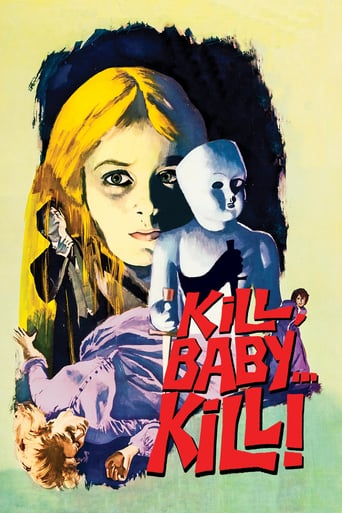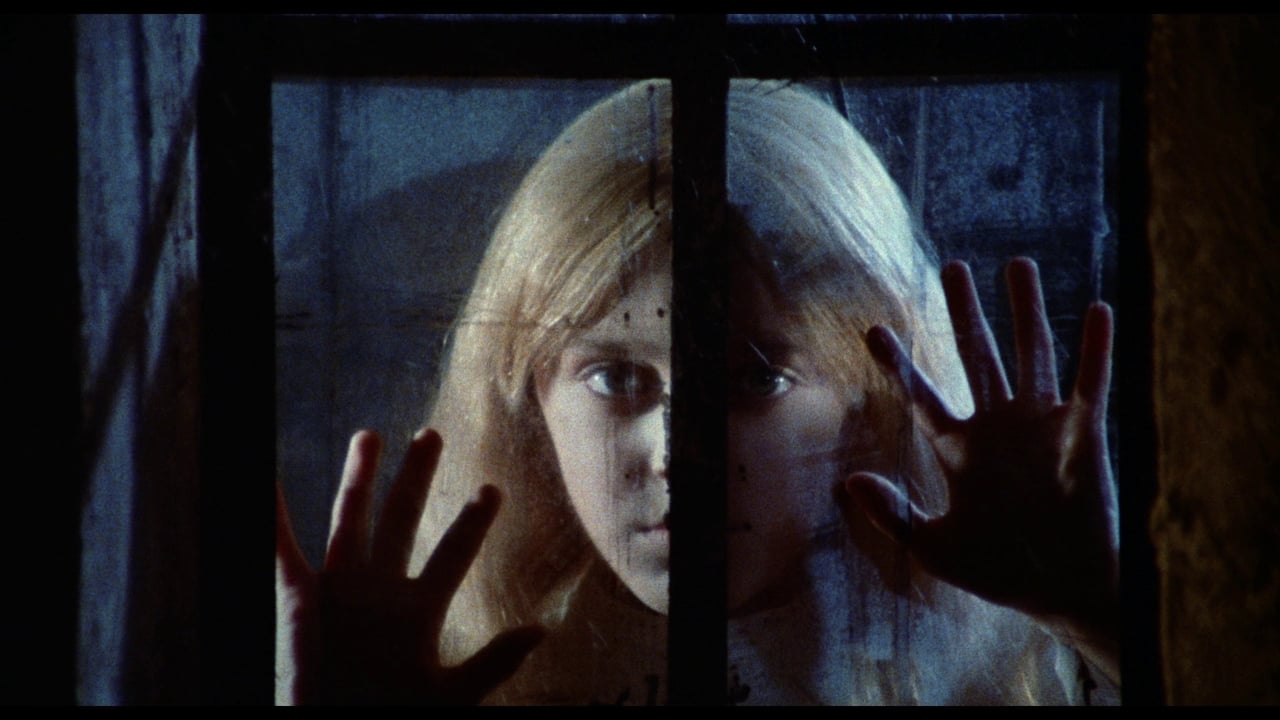LeonLouisRicci
Mario Bava Directs another Influential Gothic Horror Film. The Producers ran out of Money after 2 Weeks of Filming and the Cast and Crew Worked Without Pay and Finished the Film.It is Truly Amazing what a True Artist can Achieve with Virtually No Money, just Inspiration and Talent. Bava is in a Category of the Considerably Creative Auteurs Making Movies in the 20th Century.His Name can be Invoked, Without Apology, with the likes of Fritz Lang, James Whale, Alfred Hitchcock, Val Lewton, Roger Corman, Hammer Studios, Dario Argento, Stanley Kubrick, and David Lynch.One only needs to View this Film to Recognize Immediately its Influence on Today's Filmmakers. Scenes, Shots, and Sets from this Bava Blast of Gothic Grotesqueness are Stolen and Imitated Freely by Moderns.The Film is Draped and Framed with Excessive Atmosphere and Iconography of the Imagination and the Spiritual. Fog, Cobwebs, Gargoyles, Tombstones, Ghosts, Crucifixes, Corpses, Bell Towers, Dolls, Mirrors, Windows, and More.Surreal, Dreamlike, and Foreboding the Movie Drips with Dread. It is Claustrophobic and You can Cut the Air with a Knife. It is 86 Minutes of Murky, Methodical Mayhem as the Horror and the Uncanny Unfolds to the Final Shot of a Sunrise.It is a Brief Few Seconds, the Only Few Seconds in the Film, where the Light Finally Finds its way to this Netherworld where Superstition and the Supernatural Compliment and Completely Control the Living and the Dead.Note...Until recently the prints available have been in the Public Domain and are awful representations of this artistic achievement. Please seek out the newly released DVDs and Blu-rays. If you have only seen one of the aforementioned cheapies, you haven't really seen the Film.
tomgillespie2002
Horror maestro Mario Bava always had a unique talent for producing the most extraordinary films on the slimmest of budgets. He made Danger: Diabolik, one of his greatest works, for way less than the budget handed to him by super-producer Dino de Laurentis. Kill, Baby... Kill!, also known under the less enticing title of Curse of the Dead, is no different. With the budget provided by small-time Italian production company F.U.L. Films already microscopic, the movie was almost scrapped all together when the budget dried up just days into filming. However, Bava prevailed, and somehow managed to convince the cast and crew to work for next to nothing, and in some cases, for nothing at all. Using his skill for improvisation with camera and lighting, Kill, Baby... Kill! is rich in atmosphere, even offering the odd fright, and is now considered a masterpiece by some and one of Bava's finest achievements.After a woman mysteriously flings herself onto a set of spikes in an abandoned church, Dr. Paul Eswai (Giacomo Rossi Stuart) is called to a remote Carpathian village to perform the autopsy. He is immediately met with hostility, as the highly superstitious villagers are used to the more primitive practice of burying the body without medical examination. Already investigating the case is grizzled detective Kruger (Piero Lulli), who warns Eswai of the villagers belief in a ghostly presence around the time that places a curse on a person who always turns up dead shortly after. When Kruger goes missing while paying a visit to the secretive Baroness Graps (Giovanna Galletti), the young daughter of an innkeeper sees the ghostly apparition of a young blonde girl and believes she will be next to take her own life. Questioning everything he sees and hears, Eswai turns to village sorceress Ruth (Fabienne Dali) to try and understand these medieval practices.While I disagree that Kill, Baby... Kill! even comes close to being Bava's best film, this is without a doubt his greatest achievement. Working with very little, Bava somehow manages to conjure up an incredibly spooky, Gothic atmosphere, with beautifully decorated interiors and stunningly framed exteriors, complement with elegant camera movements. When the action moves away from the lushness of the sets and the story starts to emerge, long periods are spent with Eswai simply wandering from one place to the next. Rossi Stuart is hardly the most charismatic actor, although he certainly isn't helped by the questionable dubbing, and his romance with Monica (Erika Blanc), a native who returns to the village to claim her inheritance, proves to be as equally plodding. Still, while this is relatively routine, formulaic stuff in terms of narrative, Bava more than makes up for it with a sumptuous colour palette, and some of the most striking imagery to be found in horror.
Red-Barracuda
This colour-drenched Gothic horror film from Italian master Mario Bava is full to the brim with atmosphere and style. A doctor travels to a remote village to perform an autopsy on a woman who has died in mysterious circumstances. He immediately finds himself in the midst of a series of similar unexplained deaths. Everything seems to be connected to an ominous nearby house, the Villa Graps. While the malevolent ghost of little girl terrorises the vicinity
Kill, Baby
Kill! may sport a title that makes it sound like it should be a Russ Meyer sexploitation flick but to all intents and purposes this is pure Bava. It contains most of the elements that are associated with the great man's work: terrific fluid cinematography, beautiful use of colour and light, and strong atmospherics. It benefits too from a pretty good cast. Giacomo Rossi-Stuart is solid as the doctor while there is strong support from the beautiful and very Gothic Fabienne Dali as the local sorceress. Carlo Rustichelli pipes in too with a good score that sounds very like his soundtrack to Blood and Black Lace. But it also has an eerie section that accompanies the ghostly girl. This latter presence is well used throughout the picture. She appears in the night looking through windows, while her bouncing ball follows her around and adds splendid macabre detail - the ball led to the girl's death in the first place.Like all Bava films, this one is an exercise in cinematic style. Mostly, visual style. Many of the compositions are beautifully conceived and lit. Bava's camera gracefully captures it all and the sets are awash with striking colour and lit to perfection. In a couple of standout scenes the director puts together sequences of surreal splendour. One features a spiral staircase and the other has a man chase a figure through a maze of identical rooms until he finally catches him only to discover it is himself he has been chasing.Like many of Bava's films the story isn't really very great. Its serviceable and no more. But this is ultimately only a minor point as it's the style in which the story is told that is the main draw. And this is a great film from a master of visual cinematic style.
gavin6942
A doctor (Giacomo Rossi-Stuart) goes to a small town in the Carpathian mountains some time around 1910 in order to perform an autopsy. The villagers are generally not pleased with this, but he presses on. At the same time, there is rumor of a ghost that appears just prior to death... and somehow these two events are connected.I had not much experience with the work of Mario Bava, having been more familiar with the splatter subgenre of his son Lamberto. But I had always heard great things of Mario, and knew this film was considered by many to be a strong, memorable piece... most notably for a scene where the doctor chases himself or a doppelganger through a series of identical rooms. This scene is pretty great and pulled off very well for the time, no special effects needed. The Gothic atmosphere is also well captured, on par with Hammer films or the Poe works of Roger Corman.I find this film to be something of a tightrope between Fritz Lang's "M" and Peter Medak's "Changeling". Like "M", there is a leitmotif connected to the evil force -- in "M", the whistled tune. Here, a bouncing ball. Likewise, the ball here is somewhat replicated in "Changeling", though no longer as a forewarning to the killer. Also, the colorful imagery here really anticipates the later Italian directors, particularly Argento.Although Luca Palmerini calls the film overrated, he does say the "to the devil a daughter" theme started here and was taken up by Fellini in Toby Dammitt in "Spirits of the Dead" and later in Friedkin's "The Exorcist". I think this is a bit of stretch to connect this film to "Exorcist". Again, the white, bouncing ball symbolizing a dead child, as would later be done to great effect in "The Changeling", is the real key here to future film.To really understand and appreciate Bava, I feel one would have to watch "Black Sabbath" or "Planet of the Vampires", but this film shall be considered my introduction to the man, and I loved him from the first camera shot. I would strongly urge others to meet him in a similar way. Different releases exist, some probably better than others. I watched two different DVDs, the better one being produced by Diamond Entertainment, but I assume a still better print exists.


 AD
AD




